|
Conventional Element
|
How is it used in
Action/Adventure films?
|
|
Protagonist
|
The protagonist is the hero in the movie. Usually, they are good.
They would usually fight the antagonist and save the civilians while they are
fighting. One of the common codes and conventions is a dismal in distress.
This person is the protagonist’s girlfriend or someone he loves. The
antagonist would usually capture this person force the protagonist the fight.
This would happen in the middle of the film. |
|
Antagonist
|
The antagonist is the villain in the movie. They would usually want
revenge from the protagonist has the protagonist has done something bad. They
would usually have a special ability which is unique to the person. The antagonist would usually have a layer.
The antagonist would usually have a goal and will do anything to accomplish
it. At the end, the antagonist always loses.
|
|
Other characters
|
The other characters would be a sidekick, a damsel in distress and
the family of the protagonist. These characters are important in the movie
because they are used later on for the protagonist to help. In addition, the
antagonist might have minions to help the antagonist out.
|
|
Plot
|
In the start the protagonist would be an average person and then gets
the special ability. He would then use it to save the people. The protagonist
would then face something difficult to accomplish. When they battle, it would
be set in the urban city with the skyscraper to make it look intense for the
audience.
|
|
Locations
|
While the protagonist and the antagonist are fighting, it is usually
set in a big city. This has been used to show us that they are fighting in
big skyscrapers and we the audience would want to see chaos. It would attract
us the audience as we would want to see these buildings be destroyed. Green
screens would be used for this. It would also be held in the antagonist’s
layer.
|
|
Soundtrack
|
There would usually be slow music in the romantic part. There would
be fast music in the action and when it starts to build up, this would create
tension it makes us want to find out what is going to happen and who is going
to win. When someone dies, the music
would suddenly stop which makes us be in shock. For example, in Harry Potter
when Voldermout dies the music stops and then there is slow music.
|
|
Camera
|
One of the main camera techniques used is a point of view shot. This
is because when the protagonist is thinking or looking at something which is
important to the story. This technique is used so it would make us be like
the protagonist as we are thinking the same way.
|
|
Mise-en-Scene
|
The protagonist would usually have make up for the face to match the
costume. The dismal in distress would generally have make up to make her look
attractive. When the protagonist is in costume it would tell us that he is
going to do something or help someone as the protagonist wouldn’t goes as
himself.
|
|
Editing
|
Lighting is used to show who is the protagonist and the antagonist.
It is been used to make us know who is who. Without this, we would be
confused and wouldn’t know whose side to be on and due to this you wouldn’t
know what is going to happen. |
|
Representation
|
Representation is used to sow different effects on different types of things. For example, the protagonist is shown as kind, strong and brave making us the audience be on his side. For the antagonist, he would be unattractive and much older than the protagonist. This makes us not want to be in his side as the antagonist is a bad person.
|
Tuesday, 15 October 2013
Conventional Elements used in action/adventure films
Sunday, 13 October 2013
The Amazing Spider Man (Bridge Scene)
From the codes and conventions, you can see that this is an action/adventure film. There are many conventions which show this. I will be talking about the: camera techniques,sound and editing. These points will be discussed in further detail below. The camera zooms out tho make us see spider above the bridge.
Firstly, when car was zoomed out it showed us what had happened to it. Then it zooms into the bridge. When the car crashes, the camera shows us which part got hit. When the person looking, it is showing a point of view shot to show us what he was looking at. At 1:00, a mid shot was used to show us what he was doing. It zooms into his spider at the back of his costume to show that he is going to save the people as he is the protagonist. When a person is shouting that his child is on the car, cross cutting editing was used to show us that two scenes are going on at once and it makes us the audience think what the protagonist is going to do. When spiderman flies through the sky with his webs jump cut editing was used because we wouldn't want to see him fly if he does nothing. A close up shot of spidermans shot was used to show us his expression when he was saving the child and showing us that how difficult it was for him. A mid shot was used whwn spiderman shoots a web at the child when he was falling. At the end, the camera zooms in to his face as he was happy when the dad got happy when spiderman saved the child. These techniques and editing was used to show us how each character was.In addition, it showed us med/close up shots when spiderman was saving people.
In the beginning of the scene, it is using a low pitch sound showing something bad is happening. Then, mysterious sound is being used to show what is happening and the car horns back that up. When the car crashes and when the person gets annoyed, the music starts to build up. The music starts developing when the protagonist comes. When the protagonist helps on of the casualties the music stops developing. The music stops when he tries to save a kid while they are having a conversation. When the car burns, the music gets slow to make us think what is going to happen to the boy. When the boy wears the mask, the tone of the music gets happier. When the child's dad asks him how spiderman actually was the music stats to build up. These sounds are usually used in an action/adventure movie because if something intense occurs, the music has to be suited with it. For example, when spiderman was saving the child, the music started to build up to make us what to think what is going to happen, which creates the intensity of the scene.
Tuesday, 8 October 2013
Sunday, 6 October 2013
Action/Adventure music
1. Sound such as gun shooting, helicopters from a distance and people creaming are examples of conventions in an action/adventure movie. These things would be used in this particular type of genre, because these are the main codes and conventions which would occur in this particular type of movie.
2. Music can be used to create tension. This technique is used to make the audience get engaged and wonder what is going to happen. This is used to attract the audience and without this, the audience wouldn't know what mood it is in. For example, slow music is used to create tension. This is meant by making us want to find out what is going to happen. In addition, fast music is to show the action or something going on.
3. Sound is used to the targeted audience to create the mood of the scene. It is used to target particular audience because different music has different effects, hence some movies are targeted to a particular audience.
4. The Amazing Spider Man clip- Take It
In the beginning of the scene when The basketball player was trying to get the ball of Peter, the music had a happy/funny tone. This has been used to show the comedy in the movie. It could have also been used to break up the tension before this scene has occured.
In the end of the scene, when Peter tried to get ball into the hoop, the music was going fast. This means that it is creating tension and makes us want to find out if he shoots the ball in the hoop.
Wednesday, 2 October 2013
Camera Shots/Angles/Movements
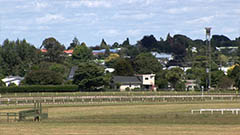
EWS (Extreme Wide Shot)
The view is so far from the subject that he isn't even visible. Often used as an establishing shot.
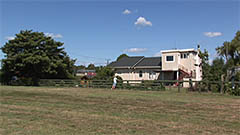
VWS (Very Wide Shot)
The subject is visible (barely), but the emphasis is still on placing him in his environment.

WS (Wide Shot)
The subject takes up the full frame, or at least as much as comfortably possible.
AKA: long shot, full shot.

MS (Mid Shot)
Shows some part of the subject in more detail while still giving an impression of the whole subject.
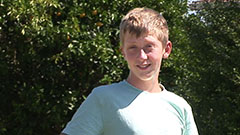
MCU (Medium Close Up)
Half way between a MS and a CU.

ECU (Extreme Close Up)
The ECU gets right in and shows extreme detail.
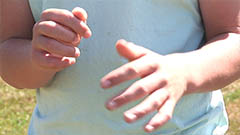
Cut-In
Shows some (other) part of the subject in detail.
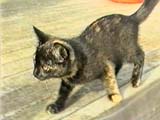
CA (Cutaway)
A shot of something other than the subject.
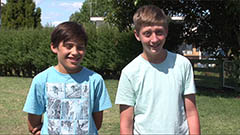
Two-Shot
A shot of two people, framed similarly to a mid shot.
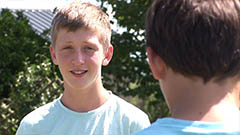
(OSS) Over-the-Shoulder Shot
Looking from behind a person at the subject.
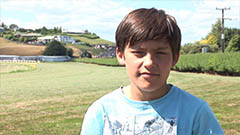
Noddy Shot
Usually refers to a shot of the interviewer listening and reacting to the subject.
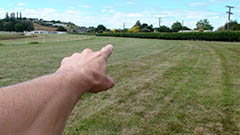
Point-of-View Shot (POV)
Shows a view from the subject's perspective.

Weather Shot
The subject is the weather. Can be used for other purposes, e.g. background for graphics.
1 . Extreme long shot
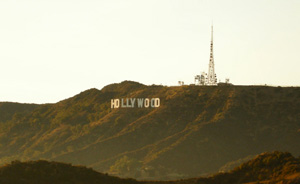
Extreme Long Shot
This can be taken from as much as a quarter of a mile away, and is generally used as a scene-setting, establishing shot. It normally shows an EXTERIOR, eg the outside of a building, or a landscape, and is often used to show scenes of thrilling action eg in a war film or disaster movie. There will be very little detail visible in the shot, it's meant to give a general impression rather than specific information.
The extreme long shot on the left is taken from a distance, but denotes a precise location - it might even connote all of the entertainment industry if used as the opening shot in a news story.
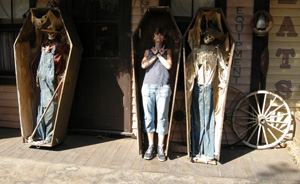
Long Shot
2. Long Shot
This is the most difficult to categorise precisely, but is generally one which shows the image as approximately "life" size ie corresponding to the real distance between the audience and the screen in a cinema (the figure of a man would appear as six feet tall). This category includes the FULL SHOT showing the entire human body, with the head near the top of the frame and the feet near the bottom. While the focus is on characters, plenty of background detail still emerges: we can tell the coffins on the right are in a Western-style setting, for instance.

Medium Shot
3. Medium Shot
Contains a figure from the knees/waist up and is normally used for dialogue scenes, or to show some detail of action. Variations on this include the TWO SHOT (containing two figures from the waist up) and the THREE SHOT (contains 3 figures...). NB. Any more than three figures and the shot tends to become a long shot. Background detail is minimal, probably because location has been established earlier in the scene - the audience already know where they are and now want to focus on dialogue and character interation. Another variation in this category is the OVER-THE-SHOULDER-SHOT, which positions the camera behind one figure, revealing the other figure, and part of the first figure's back, head and shoulder.

Close up
4. Close-Up
This shows very little background, and concentrates on either a face, or a specific detail of mise en scène. Everything else is just a blur in the background. This shot magnifies the object (think of how big it looks on a cinema screen) and shows the importance of things, be it words written on paper, or the expression on someone's face. The close-up takes us into the mind of a character. In reality, we only let people that we really trust get THAT close to our face - mothers, children and lovers, usually - so a close up of a face is a very intimate shot. A film-maker may use this to make us feel extra comfortable or extremely uncomfortable about a character, and usually uses a zoom lens in order to get the required framing.
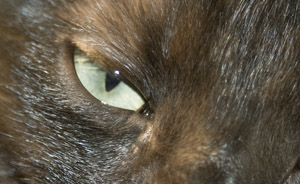
Extreme Close Up
5. Extreme Close-Up
As its name suggests, an extreme version of the close up, generally magnifying beyond what the human eye would experience in reality. An extreme close-up of a face, for instance, would show only the mouth or eyes, with no background detail whatsoever. This is a very artificial shot, and can be used for dramatic effect. The tight focus required means that extra care must be taken when setting up and lighting the shot - the slightest camera shake or error in focal length is very noticeable.
Camera Angles
The relationship between the camera and the object being photographed (ie the ANGLE) gives emotional information to an audience, and guides their judgment about the character or object in shot. The more extreme the angle (ie the further away it is from eye left), the more symbolic and heavily-loaded the shot.
1. The Bird's-Eye view
This shows a scene from directly overhead, a very unnatural and strange angle. Familiar objects viewed from this angle might seem totally unrecognizable at first (umbrellas in a crowd, dancers' legs). This shot does, however, put the audience in a godlike position, looking down on the action. People can be made to look insignificant, ant-like, part of a wider scheme of things. Hitchcock (and his admirers, like Brian de Palma) is fond of this style of shot.
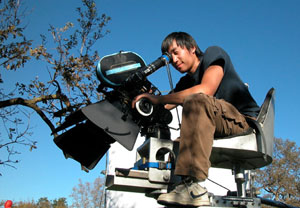
A cameraman, raised above the action, gets a high angle shot
2. High Angle
Not so extreme as a bird's eye view. The camera is elevated above the action using a crane to give a general overview. High angles make the object photographed seem smaller, and less significant (or scary). The object or character often gets swallowed up by their setting - they become part of a wider picture.
3. Eye Level
A fairly neutral shot; the camera is positioned as though it is a human actually observing a scene, so that eg actors' heads are on a level with the focus. The camera will be placed approximately five to six feet from the ground.
4. Low Angle
These increase height (useful for short actors like Tom Cruise or James McAvoy) and give a sense of speeded motion. Low angles help give a sense of confusion to a viewer, of powerlessness within the action of a scene. The background of a low angle shot will tend to be just sky or ceiling, the lack of detail about the setting adding to the disorientation of the viewer. The added height of the object may make it inspire fear and insecurity in the viewer, who is psychologically dominated by the figure on the screen.
5. Oblique/Canted Angle
Sometimes the camera is tilted (ie is not placed horizontal to floor level), to suggest imbalance, transition and instability (very popular in horror movies). This technique is used to suggest POINT-OF-View shots (ie when the camera becomes the 'eyes' of one particular character,seeing what they see — a hand held camera is often used for this.
Camera Movement
A director may choose to move action along by telling the story as a series of cuts, going from one shot to another, or they may decide to move the camera with the action. Moving the camera often takes a great deal of time, and makes the action seem slower, as it takes several second for a moving camera shot to be effective, when the same information may be placed on screen in a series of fast cuts. Not only must the style of movement be chosen, but the method of actually moving the camera must be selected too. There are seven basic methods:
1. Pans
A movement which scans a scene horizontally. The camera is placed on a tripod, which operates as a stationary axis point as the camera is turned, often to follow a moving object which is kept in the middle of the frame.
2. Tilts
A movement which scans a scene vertically, otherwise similar to a pan.
3. Dolly Shots
Sometimes called TRUCKING or TRACKING shots. The camera is placed on a moving vehicle and moves alongside the action, generally following a moving figure or object. Complicated dolly shots will involve a track being laid on set for the camera to follow, hence the name. The camera might be mounted on a car, a plane, or even a shopping trolley (good method for independent film-makers looking to save a few dollars). A dolly shot may be a good way of portraying movement, the journey of a character for instance, or for moving from a long shot to a close-up, gradually focusing the audience on a particular object or character.

A crane in use, following the path of a balloon floating into the sky
4. Crane Shots
Basically, dolly-shots-in-the-air. A crane (or jib), is a large, heavy piece of equipment, but is a useful way of moving a camera - it can move up, down, left, right, swooping in on action or moving diagonally out of it. The camera operator and camera are counter-balanced by a heavy weight, and trust their safety to a skilled crane/jib operator.
5. The Aerial Shot
An exciting variation of a crane shot, usually taken from a helicopter. This is often used at the beginning of a film, in order to establish setting and movement. A helicopter is like a particularly flexible sort of crane - it can go anywhere, keep up with anything, move in and out of a scene, and convey real drama and exhilaration — so long as you don't need to get too close to your actors or use location sound with the shots.
Subscribe to:
Comments (Atom)
